Abstract
The association with and degradation by cultured human parenchymal liver cells and human Kupffer cells of human low-density lipoprotein (LDL) was investigated in order to define, for the human situation, the relative abilities of the various liver cell types to interact with LDL. With both human parenchymal liver cells and Kupffer cells the association of LDL with the cells followed saturation kinetics which were coupled to LDL degradation. The association of LDL (per mg of cell protein) to both cell types was comparable, but the association with human Kupffer cells was much more efficiently coupled to degradation than was the case in parenchymal cells. The capacity of human Kupffer cells to degrade LDL was consequently 18-fold higher (per mg of cell protein) than that of the human parenchymal liver cells. Competition studies showed that unlabelled LDL competed efficiently with the cell association and degradation of 125I-labelled LDL with both parenchymal and Kupffer cells, while unlabelled acetyl-LDL was ineffective. The degradation of LDL by parenchymal and Kupffer cells was blocked by chloroquine and NH4Cl, indicating that it occurs in the lysosomes. Binding and degradation of LDL by human liver parenchymal cells and human Kupffer cells appeared to be completely calcium-dependent. It is concluded that the association and degradation of LDL by human Kupffer and parenchymal liver cells proceeds through the specific LDL receptor, whereas the association of LDL to Kupffer cells is more efficiently coupled to degradation. The presence of the highly active LDL receptor on human Kupffer cells might contribute significantly to LDL catabolism by human liver, especially under conditions whereby the LDL receptor on parenchymal cells is down-regulated.
Full text
PDF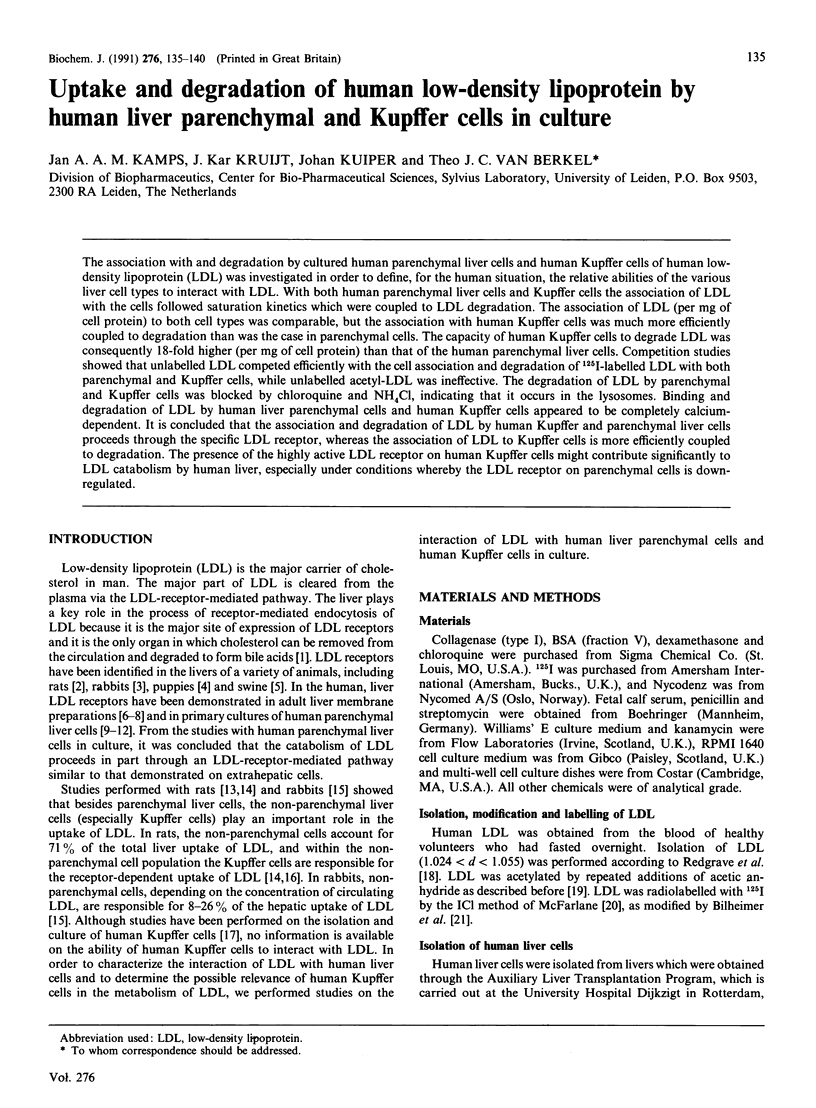
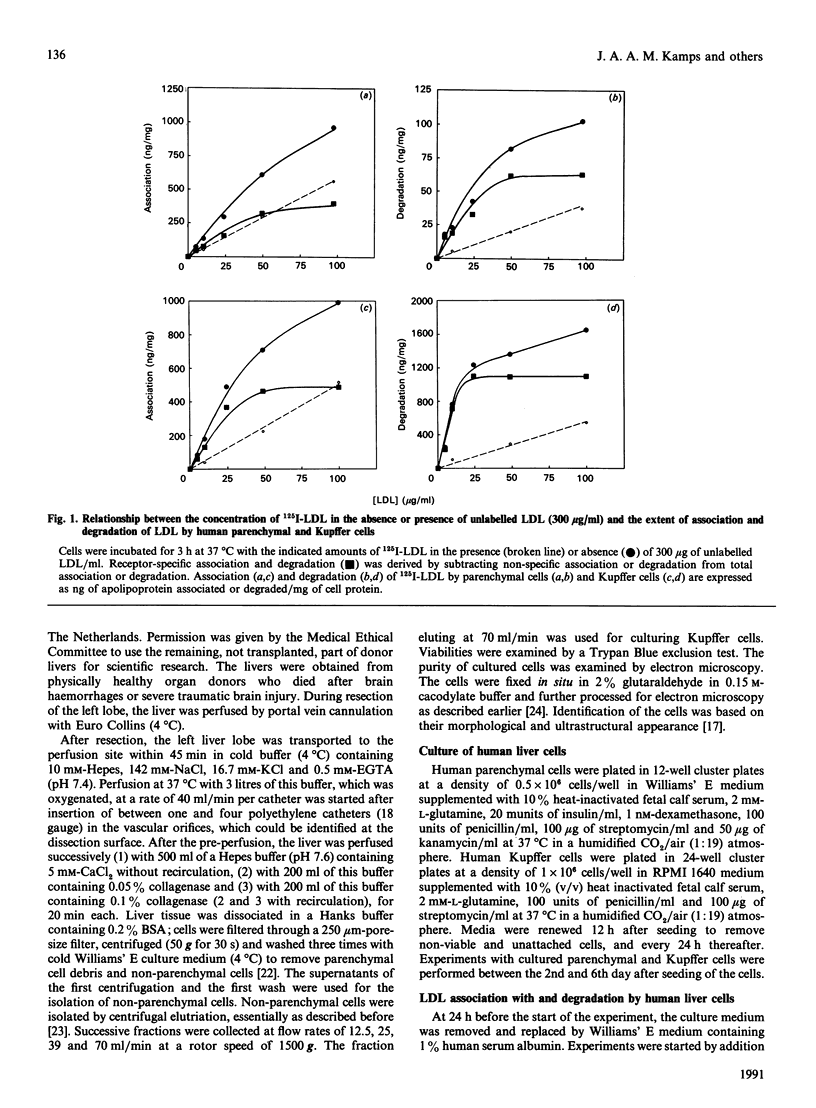
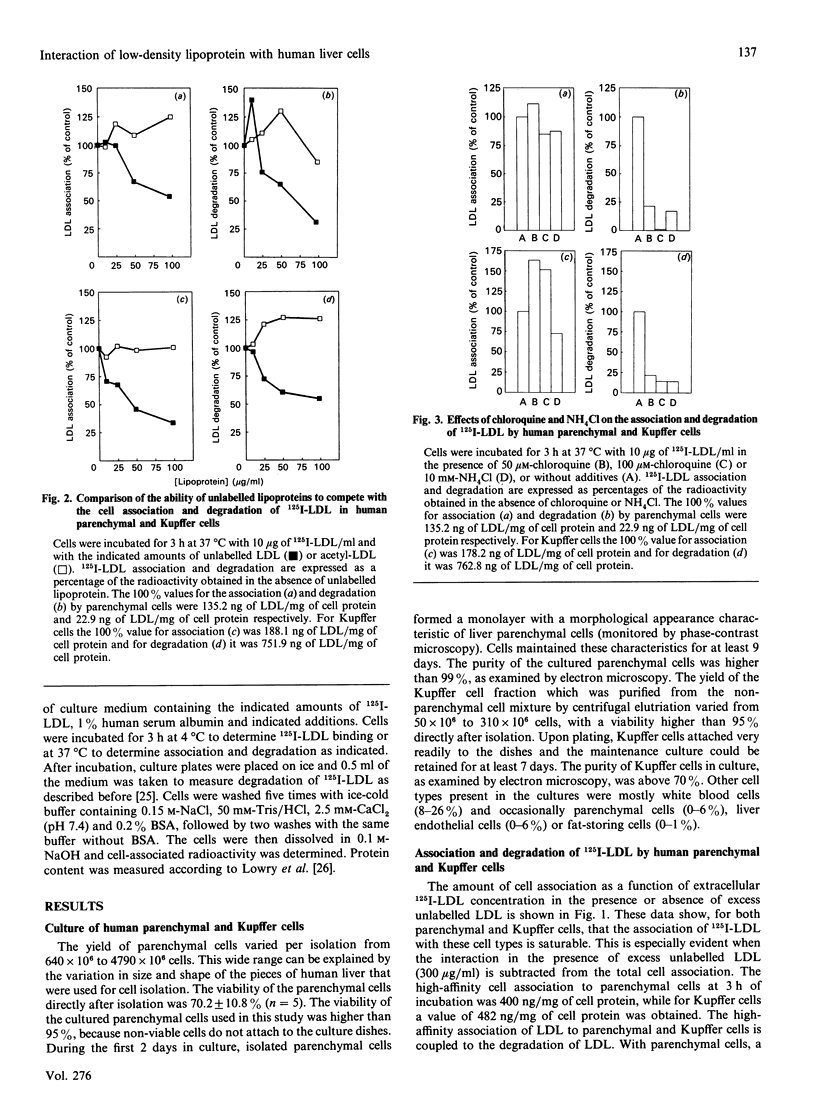
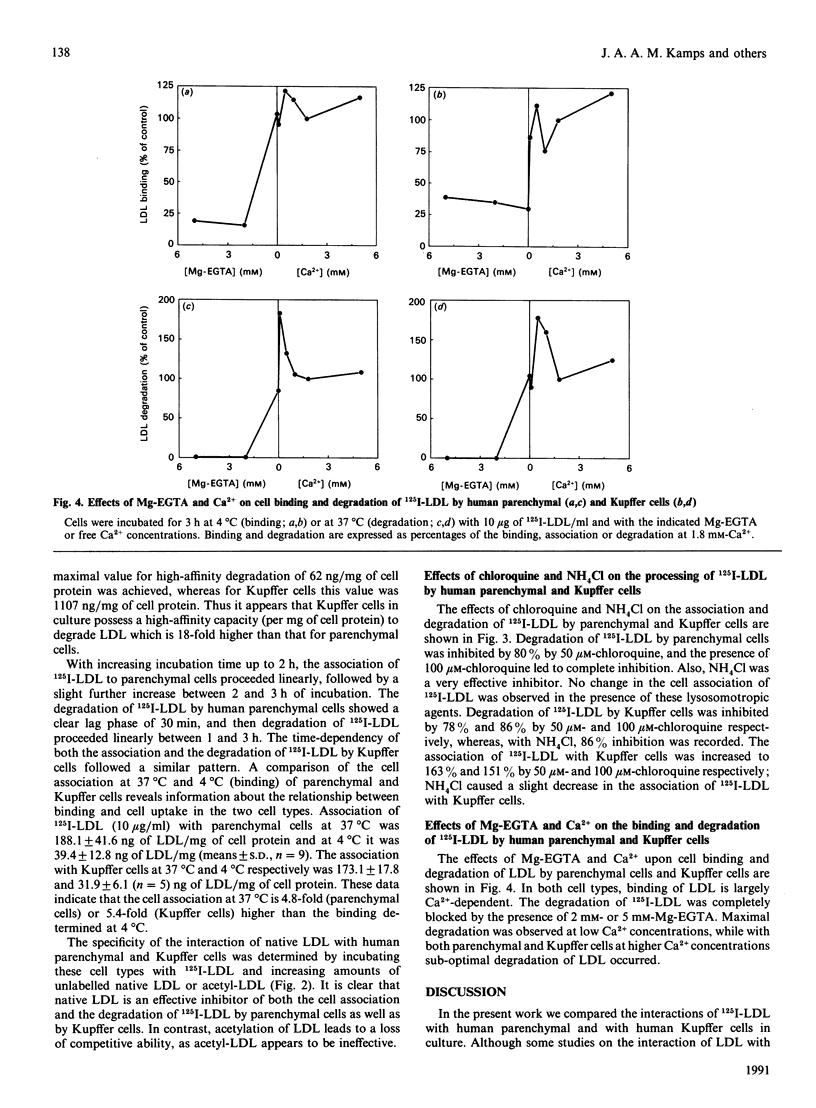
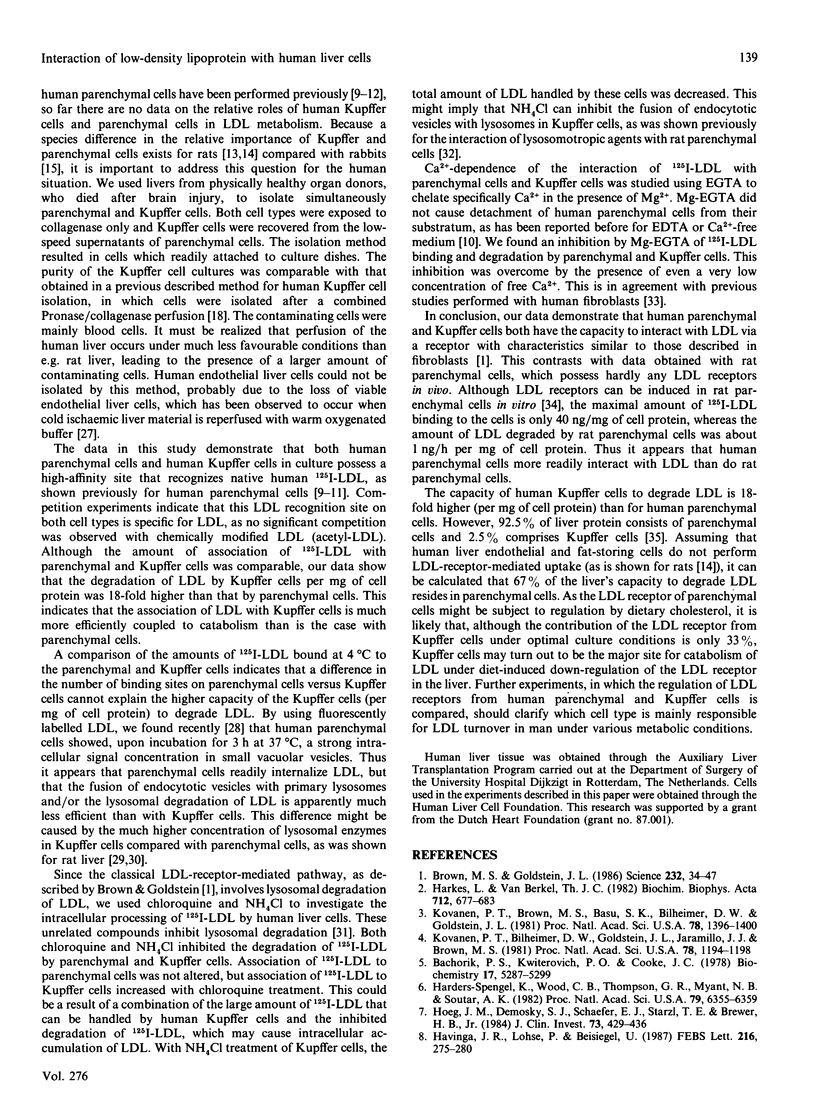
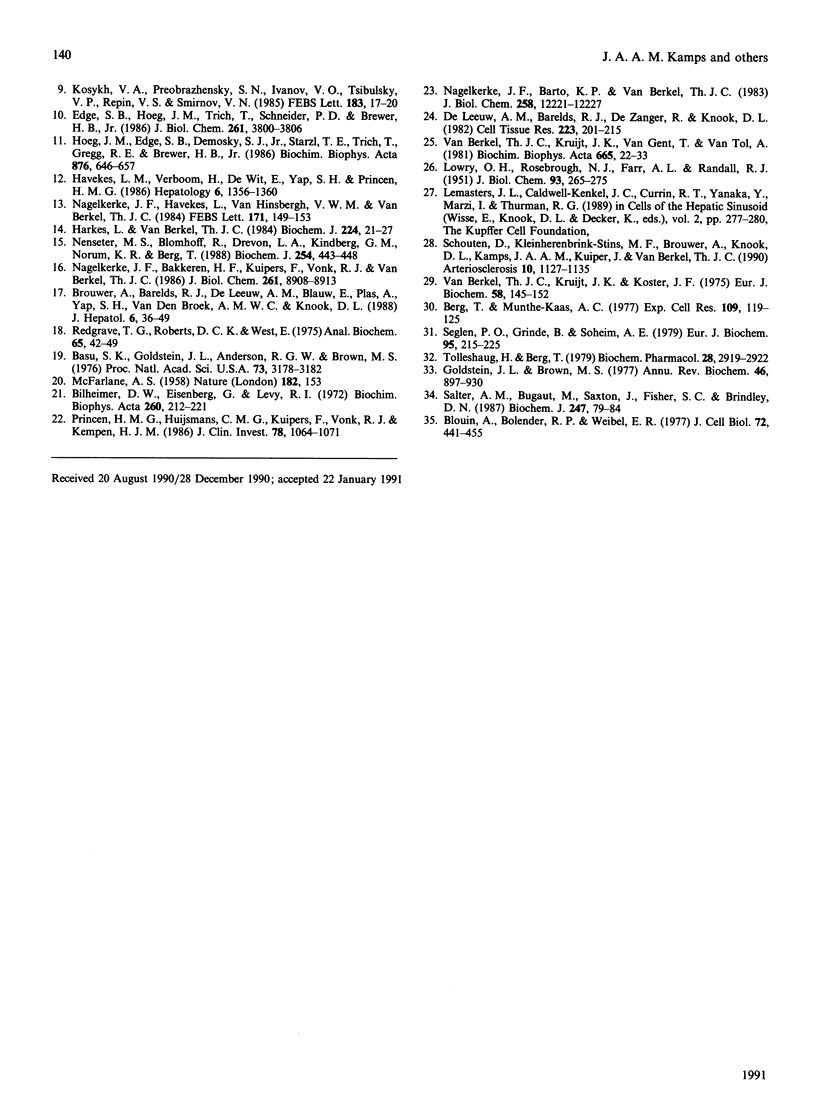
Selected References
These references are in PubMed. This may not be the complete list of references from this article.
- Bachorik P. S., Kwiterovich P. O., Cooke J. C. Isolation of a porcine liver plasma membrane fraction that binds low density lipoproteins. Biochemistry. 1978 Nov 28;17(24):5287–5299. doi: 10.1021/bi00617a032. [DOI] [PubMed] [Google Scholar]
- Basu S. K., Goldstein J. L., Anderson G. W., Brown M. S. Degradation of cationized low density lipoprotein and regulation of cholesterol metabolism in homozygous familial hypercholesterolemia fibroblasts. Proc Natl Acad Sci U S A. 1976 Sep;73(9):3178–3182. doi: 10.1073/pnas.73.9.3178. [DOI] [PMC free article] [PubMed] [Google Scholar]
- Berg T., Munthe-Kaas A. C. Lysosomal enzymes in cultured rat Kupffer cells. Exp Cell Res. 1977 Oct 1;109(1):119–125. doi: 10.1016/0014-4827(77)90051-9. [DOI] [PubMed] [Google Scholar]
- Bilheimer D. W., Eisenberg S., Levy R. I. The metabolism of very low density lipoprotein proteins. I. Preliminary in vitro and in vivo observations. Biochim Biophys Acta. 1972 Feb 21;260(2):212–221. doi: 10.1016/0005-2760(72)90034-3. [DOI] [PubMed] [Google Scholar]
- Blouin A., Bolender R. P., Weibel E. R. Distribution of organelles and membranes between hepatocytes and nonhepatocytes in the rat liver parenchyma. A stereological study. J Cell Biol. 1977 Feb;72(2):441–455. doi: 10.1083/jcb.72.2.441. [DOI] [PMC free article] [PubMed] [Google Scholar]
- Brouwer A., Barelds R. J., de Leeuw A. M., Blauw E., Plas A., Yap S. H., van den Broek A. M., Knook D. L. Isolation and culture of Kupffer cells from human liver. Ultrastructure, endocytosis and prostaglandin synthesis. J Hepatol. 1988 Feb;6(1):36–49. doi: 10.1016/s0168-8278(88)80460-4. [DOI] [PubMed] [Google Scholar]
- Brown M. S., Goldstein J. L. A receptor-mediated pathway for cholesterol homeostasis. Science. 1986 Apr 4;232(4746):34–47. doi: 10.1126/science.3513311. [DOI] [PubMed] [Google Scholar]
- Edge S. B., Hoeg J. M., Triche T., Schneider P. D., Brewer H. B., Jr Cultured human hepatocytes. Evidence for metabolism of low density lipoproteins by a pathway independent of the classical low density lipoprotein receptor. J Biol Chem. 1986 Mar 15;261(8):3800–3806. [PubMed] [Google Scholar]
- Goldstein J. L., Brown M. S. The low-density lipoprotein pathway and its relation to atherosclerosis. Annu Rev Biochem. 1977;46:897–930. doi: 10.1146/annurev.bi.46.070177.004341. [DOI] [PubMed] [Google Scholar]
- Harders-Spengel K., Wood C. B., Thompson G. R., Myant N. B., Soutar A. K. Difference in saturable binding of low density lipoprotein to liver membranes from normocholesterolemic subjects and patients with heterozygous familial hypercholesterolemia. Proc Natl Acad Sci U S A. 1982 Oct;79(20):6355–6359. doi: 10.1073/pnas.79.20.6355. [DOI] [PMC free article] [PubMed] [Google Scholar]
- Harkes L., Van Berkel J. C. Quantitative role of parenchymal and non-parenchymal liver cells in the uptake of [14C]sucrose-labelled low-density lipoprotein in vivo. Biochem J. 1984 Nov 15;224(1):21–27. doi: 10.1042/bj2240021. [DOI] [PMC free article] [PubMed] [Google Scholar]
- Harkes L., van Berkel T. J. A saturable, high-affinity binding site for human low density lipoprotein on freshly isolated rat hepatocytes. Biochim Biophys Acta. 1982 Sep 14;712(3):677–683. doi: 10.1016/0005-2760(82)90297-1. [DOI] [PubMed] [Google Scholar]
- Havekes L. M., Verboom H., de Wit E., Yap S. H., Princen H. M. Regulation of low density lipoprotein receptor activity in primary cultures of human hepatocytes by serum lipoproteins. Hepatology. 1986 Nov-Dec;6(6):1356–1360. doi: 10.1002/hep.1840060623. [DOI] [PubMed] [Google Scholar]
- Havinga J. R., Lohse P., Beisiegel U. Immunoblotting and ligand blotting of the low-density lipoprotein receptor of human liver, HepG2 cells and HeLa cells. FEBS Lett. 1987 Jun 1;216(2):275–280. doi: 10.1016/0014-5793(87)80705-6. [DOI] [PubMed] [Google Scholar]
- Hoeg J. M., Demosky S. J., Jr, Schaefer E. J., Starzl T. E., Brewer H. B., Jr Characterization of hepatic low density lipoprotein binding and cholesterol metabolism in normal and homozygous familial hypercholesterolemic subjects. J Clin Invest. 1984 Feb;73(2):429–436. doi: 10.1172/JCI111229. [DOI] [PMC free article] [PubMed] [Google Scholar]
- Hoeg J. M., Edge S. B., Demosky S. J., Jr, Starzl T. E., Triche T., Gregg R. E., Brewer H. B., Jr Metabolism of low-density lipoproteins by cultured hepatocytes from normal and homozygous familial hypercholesterolemic subjects. Biochim Biophys Acta. 1986 May 21;876(3):646–657. doi: 10.1016/0005-2760(86)90054-8. [DOI] [PMC free article] [PubMed] [Google Scholar]
- Kosykh V. A., Preobrazhensky S. N., Ivanov V. O., Tsibulsky V. P., Repin V. S., Smirnov V. N. High-affinity association and degradation of 125I-labelled low density lipoproteins by human hepatocytes in primary culture. FEBS Lett. 1985 Apr 8;183(1):17–20. doi: 10.1016/0014-5793(85)80944-3. [DOI] [PubMed] [Google Scholar]
- Kovanen P. T., Bilheimer D. W., Goldstein J. L., Jaramillo J. J., Brown M. S. Regulatory role for hepatic low density lipoprotein receptors in vivo in the dog. Proc Natl Acad Sci U S A. 1981 Feb;78(2):1194–1198. doi: 10.1073/pnas.78.2.1194. [DOI] [PMC free article] [PubMed] [Google Scholar]
- Kovanen P. T., Brown M. S., Basu S. K., Bilheimer D. W., Goldstein J. L. Saturation and suppression of hepatic lipoprotein receptors: a mechanism for the hypercholesterolemia of cholesterol-fed rabbits. Proc Natl Acad Sci U S A. 1981 Mar;78(3):1396–1400. doi: 10.1073/pnas.78.3.1396. [DOI] [PMC free article] [PubMed] [Google Scholar]
- LOWRY O. H., ROSEBROUGH N. J., FARR A. L., RANDALL R. J. Protein measurement with the Folin phenol reagent. J Biol Chem. 1951 Nov;193(1):265–275. [PubMed] [Google Scholar]
- Nagelkerke J. F., Bakkeren H. F., Kuipers F., Vonk R. J., van Berkel T. J. Hepatic processing of the cholesteryl ester from low density lipoprotein in the rat. J Biol Chem. 1986 Jul 5;261(19):8908–8913. [PubMed] [Google Scholar]
- Nagelkerke J. F., Barto K. P., van Berkel T. J. In vivo and in vitro uptake and degradation of acetylated low density lipoprotein by rat liver endothelial, Kupffer, and parenchymal cells. J Biol Chem. 1983 Oct 25;258(20):12221–12227. [PubMed] [Google Scholar]
- Nagelkerke J. F., Havekes L., van Hinsbergh V. W., van Berkel T. J. In vivo and in vitro catabolism of native and biologically modified LDL. FEBS Lett. 1984 Jun 4;171(1):149–153. doi: 10.1016/0014-5793(84)80477-9. [DOI] [PubMed] [Google Scholar]
- Nenseter M. S., Blomhoff R., Drevon C. A., Kindberg G. M., Norum K. R., Berg T. Uptake of LDL in parenchymal and non-parenchymal rabbit liver cells in vivo. LDL uptake is increased in endothelial cells in cholesterol-fed rabbits. Biochem J. 1988 Sep 1;254(2):443–448. doi: 10.1042/bj2540443. [DOI] [PMC free article] [PubMed] [Google Scholar]
- Princen H. M., Huijsmans C. M., Kuipers F., Vonk R. J., Kempen H. J. Ketoconazole blocks bile acid synthesis in hepatocyte monolayer cultures and in vivo in rat by inhibiting cholesterol 7 alpha-hydroxylase. J Clin Invest. 1986 Oct;78(4):1064–1071. doi: 10.1172/JCI112662. [DOI] [PMC free article] [PubMed] [Google Scholar]
- Redgrave T. G., Roberts D. C., West C. E. Separation of plasma lipoproteins by density-gradient ultracentrifugation. Anal Biochem. 1975 May 12;65(1-2):42–49. doi: 10.1016/0003-2697(75)90488-1. [DOI] [PubMed] [Google Scholar]
- Salter A. M., Bugaut M., Saxton J., Fisher S. C., Brindley D. N. Effects of preincubation of primary monolayer cultures of rat hepatocytes with low- and high-density lipoproteins on the subsequent binding and metabolism of human low-density lipoprotein. Biochem J. 1987 Oct 1;247(1):79–84. doi: 10.1042/bj2470079. [DOI] [PMC free article] [PubMed] [Google Scholar]
- Schouten D., Kleinherenbrink-Stins M. F., Brouwer A., Knook D. L., Kamps J. A., Kuiper J., van Berkel T. J. Characterization in vitro of interaction of human apolipoprotein E-free high density lipoprotein with human hepatocytes. Arteriosclerosis. 1990 Nov-Dec;10(6):1127–1135. doi: 10.1161/01.atv.10.6.1127. [DOI] [PubMed] [Google Scholar]
- Seglen P. O., Grinde B., Solheim A. E. Inhibition of the lysosomal pathway of protein degradation in isolated rat hepatocytes by ammonia, methylamine, chloroquine and leupeptin. Eur J Biochem. 1979 Apr 2;95(2):215–225. doi: 10.1111/j.1432-1033.1979.tb12956.x. [DOI] [PubMed] [Google Scholar]
- Tolleshaug H., Berg T. Chloroquine reduces the number of asialo-glycoprotein receptors in the hepatocyte plasma membrane. Biochem Pharmacol. 1979 Oct 1;28(19):2919–2922. doi: 10.1016/0006-2952(79)90586-0. [DOI] [PubMed] [Google Scholar]
- Van Berkel T. J., Kruijt J. K., Koster J. F. Identity and activities of lysosomal enzymes in parenchymal and non-parenchymal cells from rat liver. Eur J Biochem. 1975 Oct 1;58(1):145–152. doi: 10.1111/j.1432-1033.1975.tb02358.x. [DOI] [PubMed] [Google Scholar]
- Van Berkel T. J., Kruijt J. K., Van Gent T., Van Tol A. Saturable high affinity binding, uptake and degradation of rat plasma lipoproteins by isolated parenchymal and non-parenchymal cells from rat liver. Biochim Biophys Acta. 1981 Jul 24;665(1):22–33. doi: 10.1016/0005-2760(81)90227-7. [DOI] [PubMed] [Google Scholar]
- de Leeuw A. M., Barelds R. J., de Zanger R., Knook D. L. Primary cultures of endothelial cells of the rat liver: a model for ultrastructural and functional studies. Cell Tissue Res. 1982;223(1):201–215. doi: 10.1007/BF00221510. [DOI] [PubMed] [Google Scholar]


